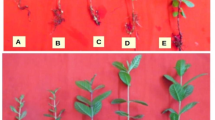Abstract
During a nematode survey, severe infections of tobacco feeder roots and heavy soil infestations byMeloidogyne incognita race 1 were found in S. Miguel (Azores islands, Portugal). This is the first record ofM. incognita infection of tobacco in Azores. Morphology of various life stages, analysis of the esterase electrophoretic pattern and differential host tests were used for nematode characterization and identification. Nematode-induced mature galls were spherical and/or ellipsoidal and usually contained more than one female, males and egg masses with eggs. Feeding sites were characterized by the development of giant cells that contained granular cytoplasm and many hypertrophied nuclei. Giant cell cytoplasm was aggregated along a thickened cell wall. Vascular tissues within galls appeared disorganized. The relationship between the initial nematode population density and growth of tobacco plants was tested in a glasshouse experiment in which inoculum levels varied from 0 to 512 eggs and juveniles (J2) cm−3 of soil. Seinhorst’s model was fitted to height and top fresh weight data of the inoculated and control plants. Tolerance limits with respect to plant height and fresh top weight of tobacco cv. ‘Erzegovina’ plants toM. incognita race 1 were estimated as 1.25 eggs and J2 cm−3 of soil. The maximum nematode reproduction rate was 404.7 at an initial population density of 4 eggs and J2 cm−3 of soil.
Similar content being viewed by others
References
Barker, K.R., Tood, F.A., Shane, W.W. and Nelson, L.A. (1981) Interrelationship ofMeloidogyne species with flue-cured tobacco.J. Nematol. 13:67–79.
Coolen, W.A. (1979) Methods for extraction ofMeloidogyne spp. and other nematodes from roots and soil.in: Lamberti, F. and Taylor, C.E. [Eds.] Root-knot Nematodes (Meloidogyne species) Systematics, Biology and Control. Academic Press, London, UK. pp. 317–330.
Di Vito, M., Greco, N. and Carella, A. (1983) The effect of population densities ofMeloidogyne incognita on the yield of cataloupe and tobacco.Nematol. Mediterr. 11:169–174.
Esbenshade, P.R. and Triantaphyllou, A.C. (1985) Use of enzyme phenotypes for identification ofMeloidogyne species.J. Nematol. 17:6–20.
Esbenshade, P.R. and Triantaphyllou, A.C. (1990) Isozyme phenotypes for the identification ofMeloidogyne species.J. Nematol. 22:10–15.
Fargette, M. (1987) Use of the esterase phenotype in the taxonomy of the genusMeloidogyne. 1. Stability of the esterase phenotype.Rév. Nematol. 10:39–43.
Hanounik, S.B., Osborne, W.W. and Pirie, W.R. (1975) Relationship between the population density ofMeloidogyne incognita and growth of tobacco.J. Nematol. 7:352–356.
Hartman, K.M. and Sasser, J.N. (1985) Identification ofMeloidogyne species on the basis of differential host test and perineal pattern morphology.in: Barker, K.R., Carter, C.C., and Sasser, J.N. [Eds.] An Advanced Treatise onMeloidogyne. Vol. II. Methodology. North Carolina State University Graphics, Raleigh, NC, USA. pp. 69–77.
Hussey, R.S. and Barker, K.R. (1973) A comparison of methods of collecting inocula ofMeloidogyne spp., including a new technique.Plant Dis. Rep. 57:1025–1028.
Johansen, D.A. (1940) Plant Microtechnique. McGraw-Hill Book Co., New York, NY.
Karssen, G. and Van Hoenselaar, T. (1998) Revision of the genusMeloidogyne Göeldi, 1982 (Nematoda: Heteroderidae) in Europe.Nematologica 44:713–788.
Karssen, G., Van Hoenselaar, T., Verkerk-Bakker, B. and Janssen, R. (1995) Species identification of rootknot nematodes from potato by electrophoresis of individual females.Electrophoresis 16:105–109.
Lamberti, F. (1971) Primi risultati di lotta nematocida su tabacchi levantini in provincia di Lecce.Tabacco 738:5–10.
Marull, J. and Pinochet, J. (1991) Host suitability ofPrunus rootstock to fourMeloidogyne species andPratylenchus vulnus in Spain.Nematropica 21:185–195.
Pais, C.S. and Abrantes, I.M. de O. (1989) Esterase and malate dehydrogenase phenotypes in Portuguese populations ofMeloidogyne species.J. Nematol. 21:342–346.
Pais, C.S., Abrantes, I.M. de O., Fernandes, M.F.M. and Santos, M.S.N. de A. (1986) Técnica de electroforese aplicada ao estudo das enzimas dos nemátodes-das-galhas-radiculares,Meloidogyne spp. [Electrophoretic technique for the study of enzymes of root-knot nematodesMeloidogyne spp.]Ciênc. Biol. Ecol. Syst. 6:19–34 (Portuguese, with English abstract).
Santos, M.S.N. de A., Abrantes, I.M. de O. and Fernandes, M.F.M. (1987) Identificação de populações portuguesas deMeloidogyne spp. (Nematoda: Meloidogynidae) pelas reacções induzidas em plantas diferenciadoras — III. [Identification of Portuguese populations ofMeloidogyne spp. on the basis of differential host test.]Ciênc. Biol. Ecol. Syst. 7:37–43 (Portuguese, with English abstract).
Sasanelli, N. (1994) Tables of Nematode-Pathogenicity.Nematol. Mediterr. 22:153–157.
Sasanelli, N. and D’Addabbo, T. (1998) Graphical estimation of yield losses caused by phytoparasitic nematodes.Nematologica 44:579.
Sasanelli, N., Di Vito, M. and Zaccheo, G. (1992) Population densities ofMeloidogyne incognita and growth of cabbage in pots.Nematol. Mediterr. 20:21–23.
Schweppenhauser, M.A. (1975) Source ofNicotiana tabacum resistance toMeloidogyne javanica.Tab. Int. (N.Y.) 177:40–42.
Seinhorst, J.W. (1965) The relationship between nematode density and damage of plants.Nematologica 11:137–154.
Seinhorst, J.W. (1979) Nematodes and growth of plants: formulation of the nematode-plant system.in: Lamberti, F. and Taylor, C.E. [Eds.] Root-knot Nematodes (Meloidogyne species) Systematics, Biology and Control. Academic Press, London, UK. pp. 231–256.
Sosa-Moss, C., Barker, K.R. and Daykin, M.E. (1983) Histopathology of selected cultivars of tobacco infected withMeloidogyne species.J. Nematol. 15:392–397.
Author information
Authors and Affiliations
Corresponding author
Additional information
http://www.phytoparasitica.org posting March 2, 2004.
Rights and permissions
About this article
Cite this article
Vovlas, N., Simões, N.J.O., Sasanelli, N. et al. Host-parasite relationships in tobacco plants infected with a root-knot nematode (Meloidogyne incognita) population from the Azores. Phytoparasitica 32, 167–173 (2004). https://doi.org/10.1007/BF02979783
Issue Date:
DOI: https://doi.org/10.1007/BF02979783




